-
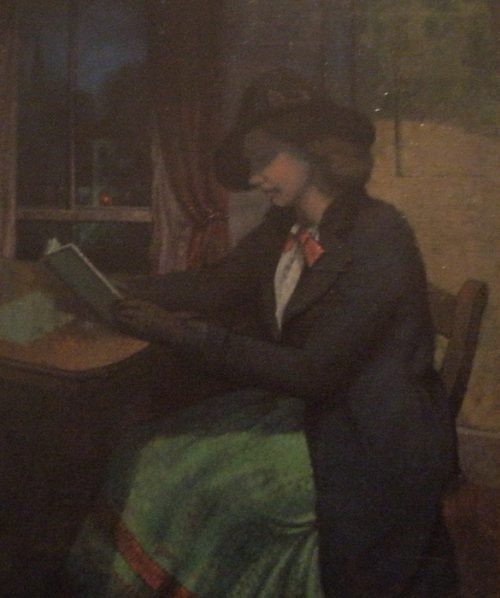 Oil on Canvas, 52x59cm. Edward Burnham Hughes N.E.A.C. 1905-1987 Provenance: New English Art Club exhibit (exhibition label verso) Frank Hughes was born at St. Pancras, London. He studied at St. Martin's School of Art in the 1920's and served in the British Army in WW2. In order to support himself he worked in administration for the London Water Board. He had an important friendship with the painter Edward Bishop R.B.A., N.E.A.C. Other contemporaries were Francis Gower, Brian Blow and Ronald Horton. He also worked with Marjorie Jenkins at and around Gooseberry Cottage, Lindsey Tye, near Hadleigh, Suffolk. His partner in later years was Kathleen Haacke MBE. He traveled with her in Italy and France, producing on their travels drawings and watercolours of landscapes and cafes: these formed the basis of subsequent paintings, often, like his portraits, dark and small. He had a hatred of the establishment and was very left wing in his outlook. He spent most of his life in Hampstead and North London, working from a studio in Muswell Hill for 25 years.
Oil on Canvas, 52x59cm. Edward Burnham Hughes N.E.A.C. 1905-1987 Provenance: New English Art Club exhibit (exhibition label verso) Frank Hughes was born at St. Pancras, London. He studied at St. Martin's School of Art in the 1920's and served in the British Army in WW2. In order to support himself he worked in administration for the London Water Board. He had an important friendship with the painter Edward Bishop R.B.A., N.E.A.C. Other contemporaries were Francis Gower, Brian Blow and Ronald Horton. He also worked with Marjorie Jenkins at and around Gooseberry Cottage, Lindsey Tye, near Hadleigh, Suffolk. His partner in later years was Kathleen Haacke MBE. He traveled with her in Italy and France, producing on their travels drawings and watercolours of landscapes and cafes: these formed the basis of subsequent paintings, often, like his portraits, dark and small. He had a hatred of the establishment and was very left wing in his outlook. He spent most of his life in Hampstead and North London, working from a studio in Muswell Hill for 25 years. -
Sold
 R.B.A., Provenance: The British Galleries c.1890 exh. 1880 - 1897 An important painting by this distinctive Victorian painter. Fred Hines lived in Essex and London painting mostly in watercolour choosing rural subject matter, which he portrayed in a romantic and sensitive style. He achieved considerable success exhibiting his works at the Royal Academy and numerous leading London galleries.
R.B.A., Provenance: The British Galleries c.1890 exh. 1880 - 1897 An important painting by this distinctive Victorian painter. Fred Hines lived in Essex and London painting mostly in watercolour choosing rural subject matter, which he portrayed in a romantic and sensitive style. He achieved considerable success exhibiting his works at the Royal Academy and numerous leading London galleries. -
Sold
 Milner R.B.C., R.W.A. d.1939 An artist with a long association with the early St. Ives School he specialised in landscapes. Born in Yorkshire he studied at the Wakefield and Doncaster Schools of Art and later at the Slade in London. He first exhibited at the Royal Academy in 1892 and from that date was a regular exhibitor at the leading galleries in London, the provinces and abroad. His work is held in several public collections.
Milner R.B.C., R.W.A. d.1939 An artist with a long association with the early St. Ives School he specialised in landscapes. Born in Yorkshire he studied at the Wakefield and Doncaster Schools of Art and later at the Slade in London. He first exhibited at the Royal Academy in 1892 and from that date was a regular exhibitor at the leading galleries in London, the provinces and abroad. His work is held in several public collections. -
Sold
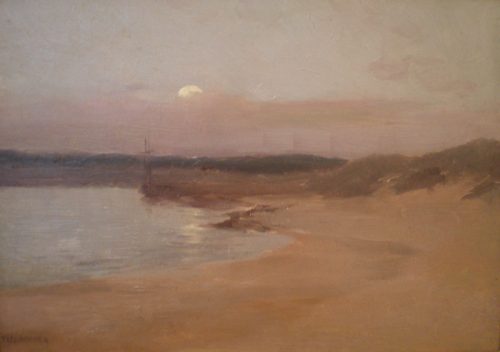 Oil on Board, 35x24cm. Milner R.B.C., R.W.A. 1860-1939 The artist arrived in St. Ives from Cheltenham, after studying at both Wakefield and Doncaster Art Schools. In the 1890's he exhibited views of Lelant at the Royal Academy. From 1903 to the end of his life he lived at Zareba on Trelohyan Hill, but traveled extensively, painting not only in the Cotswolds and Kent, but also abroad in France, Spain and Portugal. At the March Show Day in 1911 he exhibited 'A Bracing Breeze to a Gale it Grew', 'Westward as the Sun Went Down', and 'Portalegre', all in oils working from Piazza Studios, St. Ives. Working locally with STISA, he showed three large canvases at Show Day in 1924, and from 1926 with NAG. His titles include: 'Cotswold Stream' (RA 1912), 'The Pool' (1913), 'Low Tide on Bar, Evening on the South Downs' (1924), 'October Mists in Berkshire' (1924), 'The Pool Below the Hatch, Willow Herb' and 'On the Great Ouse'. Tovey comments on this fascination for Corfe Castle (Dorset) which repeatedly featured in his work. He was survived by his wife, also an artist member of STISA (no records), who died in 1947.
Oil on Board, 35x24cm. Milner R.B.C., R.W.A. 1860-1939 The artist arrived in St. Ives from Cheltenham, after studying at both Wakefield and Doncaster Art Schools. In the 1890's he exhibited views of Lelant at the Royal Academy. From 1903 to the end of his life he lived at Zareba on Trelohyan Hill, but traveled extensively, painting not only in the Cotswolds and Kent, but also abroad in France, Spain and Portugal. At the March Show Day in 1911 he exhibited 'A Bracing Breeze to a Gale it Grew', 'Westward as the Sun Went Down', and 'Portalegre', all in oils working from Piazza Studios, St. Ives. Working locally with STISA, he showed three large canvases at Show Day in 1924, and from 1926 with NAG. His titles include: 'Cotswold Stream' (RA 1912), 'The Pool' (1913), 'Low Tide on Bar, Evening on the South Downs' (1924), 'October Mists in Berkshire' (1924), 'The Pool Below the Hatch, Willow Herb' and 'On the Great Ouse'. Tovey comments on this fascination for Corfe Castle (Dorset) which repeatedly featured in his work. He was survived by his wife, also an artist member of STISA (no records), who died in 1947. -
Sold
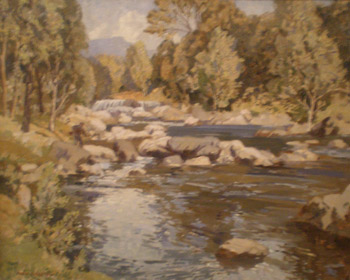 Oil on Canvas, 63x52cm. Freda Marston R.B.A., R.O.I. 1895-1949 Freda Marston, nee Culow was born in Hampstead, and studied at the very first polytechnic - Regent Street Polytechnic, founded in 1838 - followed by four years in Italy with John Terrick Williams R.A. Williams was a landscapist working in oils, watercolour and pastels, and his luminescent style greatly influenced his pupil. In 1922 she married another landscape painter, Reginald St. Clair Marston (1886-1943). She was a prolific artist, exhibiting at the Royal Academy, the Royal Society of British Artists, the Royal Institute of Oil Painters, the Royal Institute of Painters in Water Colours, the Royal Society of Artists Birmingham, the Glasgow Institute of Fine Arts, Manchester City Art Gallery, and the Royal Society of Women Artists. She was elected to the R.B.A. in 1924 and the R.O.I. in 1925. She was also the only female artist commissioned by British Rail, the London, Midland and Scottish, and the London and North Eastern Railways to produce prosters and the shallow horizontal paintings used for artwork in the railways carriages. Works in public collections include Flood the Amberley (Towner Art Gallery); Duncombe Park, Yorkshire and Lastingham, Yorkshire, both original British Railway carriage prints (National Railway Musuem).
Oil on Canvas, 63x52cm. Freda Marston R.B.A., R.O.I. 1895-1949 Freda Marston, nee Culow was born in Hampstead, and studied at the very first polytechnic - Regent Street Polytechnic, founded in 1838 - followed by four years in Italy with John Terrick Williams R.A. Williams was a landscapist working in oils, watercolour and pastels, and his luminescent style greatly influenced his pupil. In 1922 she married another landscape painter, Reginald St. Clair Marston (1886-1943). She was a prolific artist, exhibiting at the Royal Academy, the Royal Society of British Artists, the Royal Institute of Oil Painters, the Royal Institute of Painters in Water Colours, the Royal Society of Artists Birmingham, the Glasgow Institute of Fine Arts, Manchester City Art Gallery, and the Royal Society of Women Artists. She was elected to the R.B.A. in 1924 and the R.O.I. in 1925. She was also the only female artist commissioned by British Rail, the London, Midland and Scottish, and the London and North Eastern Railways to produce prosters and the shallow horizontal paintings used for artwork in the railways carriages. Works in public collections include Flood the Amberley (Towner Art Gallery); Duncombe Park, Yorkshire and Lastingham, Yorkshire, both original British Railway carriage prints (National Railway Musuem). -
Sold
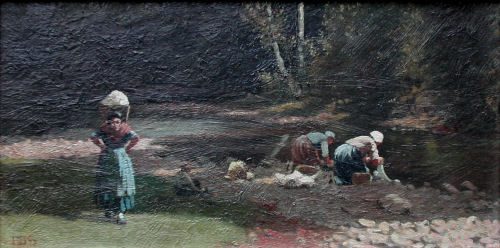 Frederick Brown N.E.A.C. 1851 - 1941 One of the most influential artists and teachers of his period, Fred Brown was one of the founding members with George Clausen, Sargent and Wilson Steer of the New English Art Club which held its first exhibition in 1886. Born in Chelmsford, Essex he was the son of a painter and art teacher. He studied first at the Royal College of Art and later in Paris under Bouguereau and Tom Fleury. He exhibited at numerous principal London galleries including the Royal Academy where he showed his celebrated work 'Hard Times'. He was Slade Professor from 1892 - 1918 and had an enormous influence on many of the most successful British painters of the early 20th Century. His work is held in a number of public collections including the Victoria and Albert Museum. He died in Richmond, Surrey in 1941 and had acquired an extensive collection of modern British paintings.
Frederick Brown N.E.A.C. 1851 - 1941 One of the most influential artists and teachers of his period, Fred Brown was one of the founding members with George Clausen, Sargent and Wilson Steer of the New English Art Club which held its first exhibition in 1886. Born in Chelmsford, Essex he was the son of a painter and art teacher. He studied first at the Royal College of Art and later in Paris under Bouguereau and Tom Fleury. He exhibited at numerous principal London galleries including the Royal Academy where he showed his celebrated work 'Hard Times'. He was Slade Professor from 1892 - 1918 and had an enormous influence on many of the most successful British painters of the early 20th Century. His work is held in a number of public collections including the Victoria and Albert Museum. He died in Richmond, Surrey in 1941 and had acquired an extensive collection of modern British paintings. -
Sold
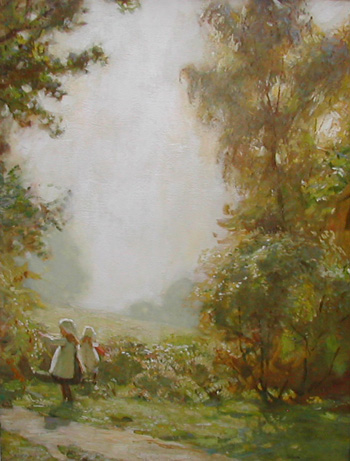 Oil on Canvas, 88x108cm. Garnet Ruskin Wolseley 1884 - 1967 Provenance : Ex private collection, It seems likely that the children depicted in this work are the daughters of Lamorna Birch and the setting is Lamorna in Cornwall. Garnet Wolseley started his formal training under Herbert Van Herkomer continuing his studies at the Slade under Henry Tonks and Fred Brown where he won a gold medal. In 1908 aged 24 he moved to Newlyn, quickly forging a close relationship with Harold and Laura Knight who had moved from Staithes the previous year. Both these artists had a considerable effect on his development as an artist.
Oil on Canvas, 88x108cm. Garnet Ruskin Wolseley 1884 - 1967 Provenance : Ex private collection, It seems likely that the children depicted in this work are the daughters of Lamorna Birch and the setting is Lamorna in Cornwall. Garnet Wolseley started his formal training under Herbert Van Herkomer continuing his studies at the Slade under Henry Tonks and Fred Brown where he won a gold medal. In 1908 aged 24 he moved to Newlyn, quickly forging a close relationship with Harold and Laura Knight who had moved from Staithes the previous year. Both these artists had a considerable effect on his development as an artist. -
Sold
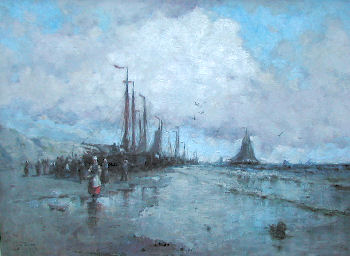 George Bunn b.1895 An outstanding marine painting by George Bunn, a relatively early impressionist artist of whom little is known. He had an address in London at the time he exhibited individual works at the Glasgow Institute, the Royal Scottish Academy and the Royal Hibernian Academy. The confident and assured style employed by the artist may suggest that he had studied on the continent. Further research will no doubt reveal more.
George Bunn b.1895 An outstanding marine painting by George Bunn, a relatively early impressionist artist of whom little is known. He had an address in London at the time he exhibited individual works at the Glasgow Institute, the Royal Scottish Academy and the Royal Hibernian Academy. The confident and assured style employed by the artist may suggest that he had studied on the continent. Further research will no doubt reveal more. -
Sold
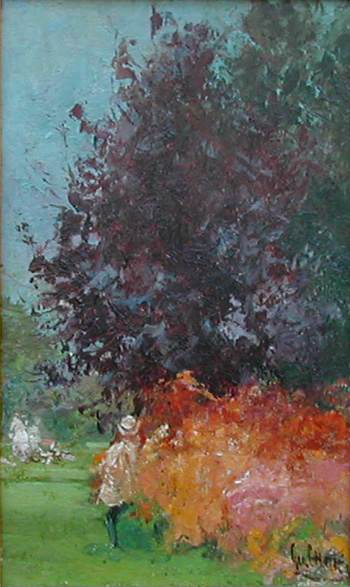 Oil on Board, 30x40cm. George Charles Haite R.I., R.O.I., R.B.A., R.B.C. 1855 - 1924 A highly talented artist, Haite worked in both oil and watercolour and as a designer produced wallpaper, leaded glass and metalwork. The son of George Haite the designer he received little encouragement from his father and was largely self taught. He arrived in London in 1872 and his early years were devoted to design work. He later turned to painting and became very successful, he first exhibited at the Royal Academy in 1883. He was elected President of the Langham Sketch Club and President of The Institute of Decorative Designers.
Oil on Board, 30x40cm. George Charles Haite R.I., R.O.I., R.B.A., R.B.C. 1855 - 1924 A highly talented artist, Haite worked in both oil and watercolour and as a designer produced wallpaper, leaded glass and metalwork. The son of George Haite the designer he received little encouragement from his father and was largely self taught. He arrived in London in 1872 and his early years were devoted to design work. He later turned to painting and became very successful, he first exhibited at the Royal Academy in 1883. He was elected President of the Langham Sketch Club and President of The Institute of Decorative Designers. -
Sold
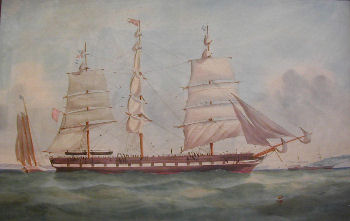 George F. Gregory 1815 - 1885 Born in England, he began his working life as a draughtsman with the Thames Iron Works. He set sail for Australia in 1848 at the time of the 1848 gold rush. By 1854 he had established himself as a specialist marine painter in Melbourne. His style has a tendency to the naive which gives his work a considerable charm. It would seem he was reasonably successful as a good number of his works survive in both private and public collections. The Peabody Museum of Salem holds three examples of his work.
George F. Gregory 1815 - 1885 Born in England, he began his working life as a draughtsman with the Thames Iron Works. He set sail for Australia in 1848 at the time of the 1848 gold rush. By 1854 he had established himself as a specialist marine painter in Melbourne. His style has a tendency to the naive which gives his work a considerable charm. It would seem he was reasonably successful as a good number of his works survive in both private and public collections. The Peabody Museum of Salem holds three examples of his work. -
Sold
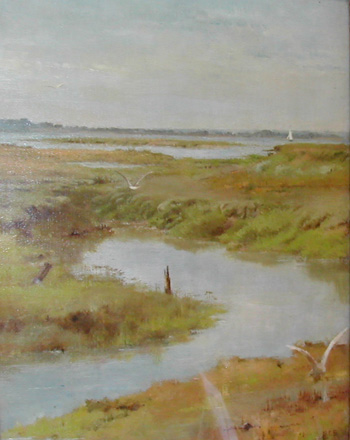 Oil on Canvas, 52x60cm. Grace M Sainsbury fl. 1888 - 1917 Provenance : Remnant of an exhibition label (possibly ROI). An exceptional example by the London based artist Grace Sainsbury who specialised in figure and landscape painting. She exhibited at many of the principle London galleries including the Royal Academy and the Society of Women Artists. This particular example is in wonderful original condition and retains its original exhibition frame.
Oil on Canvas, 52x60cm. Grace M Sainsbury fl. 1888 - 1917 Provenance : Remnant of an exhibition label (possibly ROI). An exceptional example by the London based artist Grace Sainsbury who specialised in figure and landscape painting. She exhibited at many of the principle London galleries including the Royal Academy and the Society of Women Artists. This particular example is in wonderful original condition and retains its original exhibition frame. -
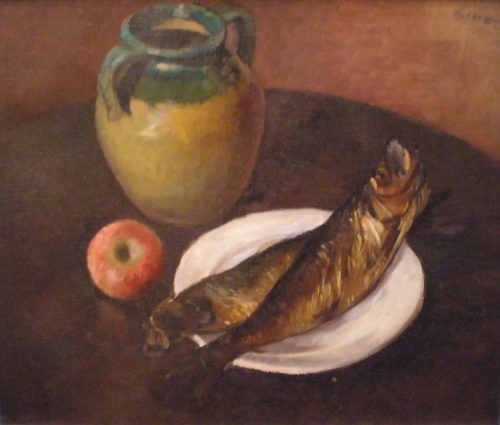 Oil on Canvas, 58x50cm. Gustave Lino 1893-1961 Provenance: Ex-private collection, Paris Gustave Lino was a French painter born in Mulhouse, October 27th 1893, and died in Algiers in 1961. He sailed for Algiers at the age of 19 in 1912, but was put in "civil prison" in Ajecco, Corsica in 1914 as a German citizen (Mulhouse was part of the German Empire since 1871). He spent the First World War on the Island of Beauty and painted among other subjects the historic Hotel Solferino Ajaccio and also completed religious decorations at the Castle Malaspena, Massa Belgodere. By December 1918 he had returned to Algiers, where he became a pupil of Georges-Antoine Rochegrosse. He exhibited at the Salon of French Artists in 1926, and Danton gallery Rue La Boetie in 1927. Besides Algeria, where there are paintings permanently held in Algiers and Bou-Saada, he travelled to Italy (coast of Naples, Sicily), Spain, Morocco and Tunisia; Sidi Bou Said, Tunis-Bizerte. He was a painter of the group known as the "Painters of Poetic Reality" (with Jean Cavailles Legueult, Planson, Maurice Brianchon), and was a close friend of Albert Marquet. Marcelle Marquet said of him that "he succeeded better than the Marquet himself". He was also praised by Albert Camus who said of Gustave Lino "His seascapes, if one feels the influence of Marquet, are not less real successes, sensitive, fresh and unique" (about the Salon Algerian artists of 1934). His palette is very colourful, often linear, with a predilection for a blue motif, not just of the northern cities of Algeria, but also the landscapes of southern Laghouat, Touggourt or El Oued, and Italy. He was a prominent member of the School of Algiers, he exhibited at the Galerie de l'Institut rue de Seine in 1956, and posthumously received the last Grand Prix Artistic of Ageria in 1962.
Oil on Canvas, 58x50cm. Gustave Lino 1893-1961 Provenance: Ex-private collection, Paris Gustave Lino was a French painter born in Mulhouse, October 27th 1893, and died in Algiers in 1961. He sailed for Algiers at the age of 19 in 1912, but was put in "civil prison" in Ajecco, Corsica in 1914 as a German citizen (Mulhouse was part of the German Empire since 1871). He spent the First World War on the Island of Beauty and painted among other subjects the historic Hotel Solferino Ajaccio and also completed religious decorations at the Castle Malaspena, Massa Belgodere. By December 1918 he had returned to Algiers, where he became a pupil of Georges-Antoine Rochegrosse. He exhibited at the Salon of French Artists in 1926, and Danton gallery Rue La Boetie in 1927. Besides Algeria, where there are paintings permanently held in Algiers and Bou-Saada, he travelled to Italy (coast of Naples, Sicily), Spain, Morocco and Tunisia; Sidi Bou Said, Tunis-Bizerte. He was a painter of the group known as the "Painters of Poetic Reality" (with Jean Cavailles Legueult, Planson, Maurice Brianchon), and was a close friend of Albert Marquet. Marcelle Marquet said of him that "he succeeded better than the Marquet himself". He was also praised by Albert Camus who said of Gustave Lino "His seascapes, if one feels the influence of Marquet, are not less real successes, sensitive, fresh and unique" (about the Salon Algerian artists of 1934). His palette is very colourful, often linear, with a predilection for a blue motif, not just of the northern cities of Algeria, but also the landscapes of southern Laghouat, Touggourt or El Oued, and Italy. He was a prominent member of the School of Algiers, he exhibited at the Galerie de l'Institut rue de Seine in 1956, and posthumously received the last Grand Prix Artistic of Ageria in 1962. -
Sold
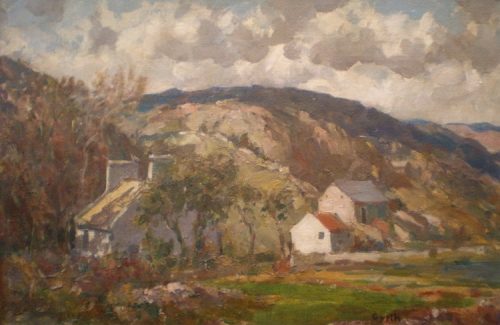 Oil on Board, 76x56cm. Russell R.B.A., R.I., R.O.I., R.S.M.A. 1892-1970 Gyrth Russell was born in Halifax, Nova Scotia in April 1892, the last of eight children. His father, a canadian M.P., was also Supreme High Court Judge for Nova Scotia. At the age of fourteen, Gyrth began his artistic career at Halifax School of Art, and quickly graduated to the School of Art at Boston Mass'. His first job was as a draughtsman in the Public Works Department of Canade, in Halifax. It was during this period he saw and sketched the cable ship 'Mackay Bennett' returning to her Halifax Station, her decks piled high with coffins containing bodies found after the Titanic disaster. In 1911 Gyrth left Canada to study at the Academie Julian and Academie Calorossi in Paris. At the outbreak of War, Gyrth left France for London where he was commissioned, under the command of Lord Beaverbrook, as an official War Artist for the Canadian Sector, and spent most of 1918 in Northern France painting the ravaged landscapes. During the course of the First World War he worked with amongst others, Augustus John, Orpen and Frank Brangwyn. Between the wars Gyrth earned his living as an artist in film studios, designing Railway posters, lecturing and writing. During this time he was elected to membership of the R.B.A., R.I., R.O.I., and the R.S.M.A., as well as being an active member of the Langham Sketchclub. In 1944, bombed out of London, Gyrth moved to Yorkshire, where apart from continuing his work as an artist, he became a regular visiting lecturer at Doncaster School of Art. In 1953 he moved for the last time, to Penarth in South Wales, where he continued to work until his death in December 1970. Whilst in South Wales his talents as an artist and a lecturer were as much in demand as ever. He became an active member of both the Watercolour Society of Wales and the South Wales Art Society. Gyrth Russell was a prolific and talented artist whose works were much more sought after during his lifetime and have become increasingly more so since his death.
Oil on Board, 76x56cm. Russell R.B.A., R.I., R.O.I., R.S.M.A. 1892-1970 Gyrth Russell was born in Halifax, Nova Scotia in April 1892, the last of eight children. His father, a canadian M.P., was also Supreme High Court Judge for Nova Scotia. At the age of fourteen, Gyrth began his artistic career at Halifax School of Art, and quickly graduated to the School of Art at Boston Mass'. His first job was as a draughtsman in the Public Works Department of Canade, in Halifax. It was during this period he saw and sketched the cable ship 'Mackay Bennett' returning to her Halifax Station, her decks piled high with coffins containing bodies found after the Titanic disaster. In 1911 Gyrth left Canada to study at the Academie Julian and Academie Calorossi in Paris. At the outbreak of War, Gyrth left France for London where he was commissioned, under the command of Lord Beaverbrook, as an official War Artist for the Canadian Sector, and spent most of 1918 in Northern France painting the ravaged landscapes. During the course of the First World War he worked with amongst others, Augustus John, Orpen and Frank Brangwyn. Between the wars Gyrth earned his living as an artist in film studios, designing Railway posters, lecturing and writing. During this time he was elected to membership of the R.B.A., R.I., R.O.I., and the R.S.M.A., as well as being an active member of the Langham Sketchclub. In 1944, bombed out of London, Gyrth moved to Yorkshire, where apart from continuing his work as an artist, he became a regular visiting lecturer at Doncaster School of Art. In 1953 he moved for the last time, to Penarth in South Wales, where he continued to work until his death in December 1970. Whilst in South Wales his talents as an artist and a lecturer were as much in demand as ever. He became an active member of both the Watercolour Society of Wales and the South Wales Art Society. Gyrth Russell was a prolific and talented artist whose works were much more sought after during his lifetime and have become increasingly more so since his death. -
Sold
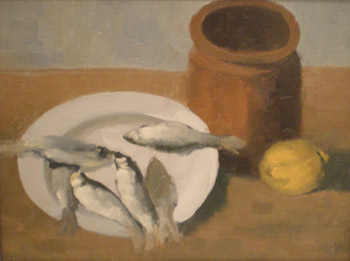 Oil on Board, 42x35cm. Mathy 1897-1978 A belgian artist, he was born in Landen and studied art at the Academy of Verviers before furthering his education in Antwerp. His studies were cut short by the outbreak of World War I with the young artist joining the army as a volunteer. His next four years would be spent in the trenches. It was during this period that he met, and was befriended by the great landscape painter Henri Houben, a chance meeting that was to pave the way for his later success as an artist. Unlike many of his contemporaries who by now were embracing expressionism, stylistically Heni Mathy still remained in the 19th Century tradition concerned with the accurate depiction of rural life. His work is renowned for its highly atmospheric quality. its subtle yet evocative colouring and technical mastery. A frequent exhibitor at numerous exhibitions throughout Belguim, he also showed in France and Germany during the 1920's. Henri Mathy died in Brussels in 1978 but his paintings can be seen today in the provincial museums of Brabant and Hainaut as well as the city museums of Charletroi, Mons and Verviers in Belgium.
Oil on Board, 42x35cm. Mathy 1897-1978 A belgian artist, he was born in Landen and studied art at the Academy of Verviers before furthering his education in Antwerp. His studies were cut short by the outbreak of World War I with the young artist joining the army as a volunteer. His next four years would be spent in the trenches. It was during this period that he met, and was befriended by the great landscape painter Henri Houben, a chance meeting that was to pave the way for his later success as an artist. Unlike many of his contemporaries who by now were embracing expressionism, stylistically Heni Mathy still remained in the 19th Century tradition concerned with the accurate depiction of rural life. His work is renowned for its highly atmospheric quality. its subtle yet evocative colouring and technical mastery. A frequent exhibitor at numerous exhibitions throughout Belguim, he also showed in France and Germany during the 1920's. Henri Mathy died in Brussels in 1978 but his paintings can be seen today in the provincial museums of Brabant and Hainaut as well as the city museums of Charletroi, Mons and Verviers in Belgium. -
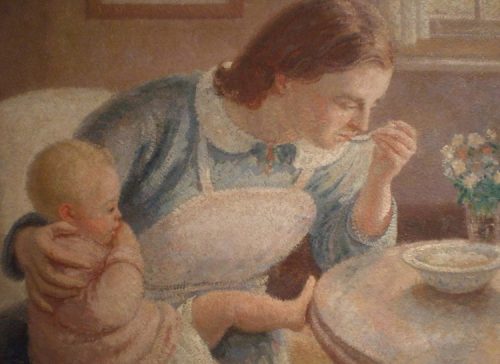 Oil on Canvas, 76x60cm. Hubert Arthur Finney 1905-1991 Provenance: Purchased from the artists son. Hubert Arthur Finney was a talented draughtsman by the age of 14. He won a trade scholarship to Beckenham School of Art and then moved to the Royal College of Art in 1924. He won the prestigious traveling scholarship to Italy and was befriended by the then Principal later Sir, William Rothenstein. His friends and contemporaries included Charles Mahoney, Percy Horton, Gerald Ososki, Barnett Friedman and Edward Le Bas. During the war he served in the Civil Defence in London driving ambulances, but became ill in late 1944 with pleurosy from debris dust. In 1945 he moved to Wokingham in Berkshire with his new wife Amy, and in 1946 too a post with the University of Reading as a lecturer in fine art where he predominantly taught life drawing. He went to the University of Milwaukee on an exchange in 1965 and on his retirement returned to England and moved to Somerset in 1969 where he lived until his death in 1991. His works have been exhibited in the National Portrait Gallery, the Royal Academy, the Louvre in Paris and some are held in public collections. A studio sale was held in 2007 by the late Duncan Campbell in his South Kensington Gallery.
Oil on Canvas, 76x60cm. Hubert Arthur Finney 1905-1991 Provenance: Purchased from the artists son. Hubert Arthur Finney was a talented draughtsman by the age of 14. He won a trade scholarship to Beckenham School of Art and then moved to the Royal College of Art in 1924. He won the prestigious traveling scholarship to Italy and was befriended by the then Principal later Sir, William Rothenstein. His friends and contemporaries included Charles Mahoney, Percy Horton, Gerald Ososki, Barnett Friedman and Edward Le Bas. During the war he served in the Civil Defence in London driving ambulances, but became ill in late 1944 with pleurosy from debris dust. In 1945 he moved to Wokingham in Berkshire with his new wife Amy, and in 1946 too a post with the University of Reading as a lecturer in fine art where he predominantly taught life drawing. He went to the University of Milwaukee on an exchange in 1965 and on his retirement returned to England and moved to Somerset in 1969 where he lived until his death in 1991. His works have been exhibited in the National Portrait Gallery, the Royal Academy, the Louvre in Paris and some are held in public collections. A studio sale was held in 2007 by the late Duncan Campbell in his South Kensington Gallery. -
Sold
 Oil, 58x75cm. Bellingham Smith N.E.A.C. 1866 - 1922 Born in London, Hugh Bellingham Smith first studied art at the Slade School of Art under Legros and then in Paris under Constant. An artist of considerable talent he exhibited at many of the principal London galleries from 1891 and was elected a member of the New English Art Club. He painted in a very distinctive style with a wide range of subject matter, often visiting Yorkshire and Cornwall for inspiration. This excellent example retains its original frame.
Oil, 58x75cm. Bellingham Smith N.E.A.C. 1866 - 1922 Born in London, Hugh Bellingham Smith first studied art at the Slade School of Art under Legros and then in Paris under Constant. An artist of considerable talent he exhibited at many of the principal London galleries from 1891 and was elected a member of the New English Art Club. He painted in a very distinctive style with a wide range of subject matter, often visiting Yorkshire and Cornwall for inspiration. This excellent example retains its original frame. -
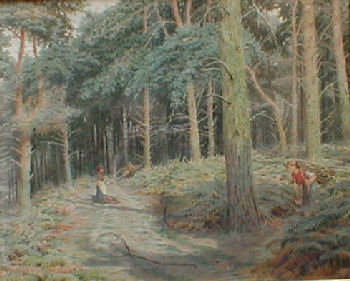 Watercolour, 11x17cm. James Barnes 1870 - 1920 James Barnes exhibited a staggering 131 works at the Walker Art Gallery in Liverpool, during his lifetime. A painter of great skill, his work has a wonderful ethereal feeling, as well as the genuine touch of the Liverpool school at this period. He appears to have spent his entire working life in Liverpool, and his commitment to the Walker Art Gallery is obvious. He exhibited at the principal galleries, both in the provinces and London, including the Royal academy. The theme of this painting appears to have been a particular favourite of the artist.
Watercolour, 11x17cm. James Barnes 1870 - 1920 James Barnes exhibited a staggering 131 works at the Walker Art Gallery in Liverpool, during his lifetime. A painter of great skill, his work has a wonderful ethereal feeling, as well as the genuine touch of the Liverpool school at this period. He appears to have spent his entire working life in Liverpool, and his commitment to the Walker Art Gallery is obvious. He exhibited at the principal galleries, both in the provinces and London, including the Royal academy. The theme of this painting appears to have been a particular favourite of the artist. -
Sold
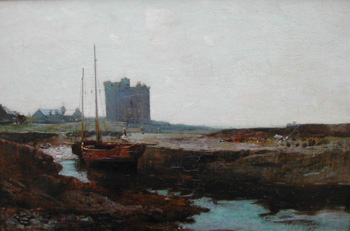 Oil on Canvas, 57x43cm. James Campbell Noble R.S.A. 1846 - 1913 James Campbell Noble was born in Edinburgh, studying first at the board of manufacture in Edinburge and later at the school of the Royal Scottish Academy under J.P.Charles and McTaggart where he won the Keith prize. He exhibited in London at the Royal Academy in 1880 and was elected as a full member of the Royal Scottish Academy in 1892.
Oil on Canvas, 57x43cm. James Campbell Noble R.S.A. 1846 - 1913 James Campbell Noble was born in Edinburgh, studying first at the board of manufacture in Edinburge and later at the school of the Royal Scottish Academy under J.P.Charles and McTaggart where he won the Keith prize. He exhibited in London at the Royal Academy in 1880 and was elected as a full member of the Royal Scottish Academy in 1892. -
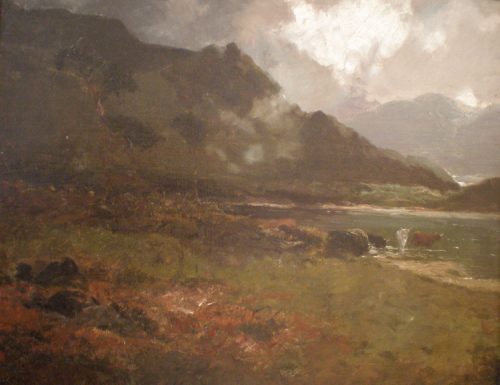 Oil on Board, 40x32cm. James Docharty A.R.S.A. 1829-1878 Docharty was born in the calico-printing district of the Vale of Leven, at Bonhill, near Bumbarton, where his father was employed in one of the numerous works for which that locality divides its fame with football playing. He served his apprenticeship as a pattern designer, which profession he persued in Glasgow until about 1861, when he took seriously to the profession of a landscape-painter, for which he always had a strong predilection. His first studies of any consequence were made at the village of Ardenadarn, a watering place on the Holy Loch on the Clyde, after which the establishment of the Glasgow Institute of the Fine Arts afforded him an opportunity of putting his works before the public. The quality of his landscapes, in which the character of Scottish landscape was simply and truthfully delineated, rapidly brought him into notice, and led to his election as an Associate of the Scottish Academy in 1877. He was a regular exhibitor at the local exhibitions, the Scottish Academy, and during the last few years of his life, at the Royal Academy, where his works were favourably noticed. In the spring on 1866, on account of his heath begining to fail, he left for a trip to Egypt, in the course of which he made some sketches of Nile scenery which he never wrought out; and afterwards spent some months at the Isle of Wight, in spite of the pulmonary complaint from which he had been suffering terminated fatally in Glasgow in 1878.
Oil on Board, 40x32cm. James Docharty A.R.S.A. 1829-1878 Docharty was born in the calico-printing district of the Vale of Leven, at Bonhill, near Bumbarton, where his father was employed in one of the numerous works for which that locality divides its fame with football playing. He served his apprenticeship as a pattern designer, which profession he persued in Glasgow until about 1861, when he took seriously to the profession of a landscape-painter, for which he always had a strong predilection. His first studies of any consequence were made at the village of Ardenadarn, a watering place on the Holy Loch on the Clyde, after which the establishment of the Glasgow Institute of the Fine Arts afforded him an opportunity of putting his works before the public. The quality of his landscapes, in which the character of Scottish landscape was simply and truthfully delineated, rapidly brought him into notice, and led to his election as an Associate of the Scottish Academy in 1877. He was a regular exhibitor at the local exhibitions, the Scottish Academy, and during the last few years of his life, at the Royal Academy, where his works were favourably noticed. In the spring on 1866, on account of his heath begining to fail, he left for a trip to Egypt, in the course of which he made some sketches of Nile scenery which he never wrought out; and afterwards spent some months at the Isle of Wight, in spite of the pulmonary complaint from which he had been suffering terminated fatally in Glasgow in 1878. -
Sold
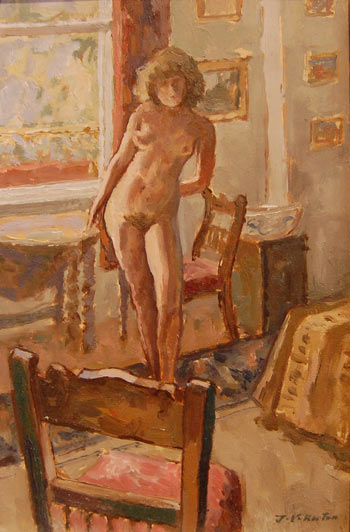 Oil on Board, 38x47cm. James Horton R.B.A. b.1948 James Horton studied first at the Sir John Cass School of Art and then at the Royal College of Art. He was quickly given his first one-man show at the Hay Galleries, Hay on Wye and quickly followed with others in Belfast, Dublin, Cambridge and Stockholm. Horton has exhibited at many principal London galleries including the Royal Academy, Royal Society of British Artists, Royal Portrait Society, New English Art Club etc. Additional information on request.
Oil on Board, 38x47cm. James Horton R.B.A. b.1948 James Horton studied first at the Sir John Cass School of Art and then at the Royal College of Art. He was quickly given his first one-man show at the Hay Galleries, Hay on Wye and quickly followed with others in Belfast, Dublin, Cambridge and Stockholm. Horton has exhibited at many principal London galleries including the Royal Academy, Royal Society of British Artists, Royal Portrait Society, New English Art Club etc. Additional information on request. -
Sold
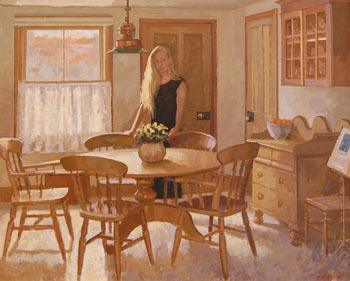 Oil on Canvas, 100x87cm. James Horton R.B.A. b.1948 James Horton studied first at the Sir John Cass School of Art and then at the Royal College of Art. He was quickly given his first one-man show at the Hay Galleries, Hay on Wye and quickly followed with others in Belfast, Dublin, Cambridge and Stockholm. Horton has exhibited at many principal London galleries including the Royal Academy, Royal Society of British Artists, Royal Portrait Society, New English Art Club etc. Additional information on request.
Oil on Canvas, 100x87cm. James Horton R.B.A. b.1948 James Horton studied first at the Sir John Cass School of Art and then at the Royal College of Art. He was quickly given his first one-man show at the Hay Galleries, Hay on Wye and quickly followed with others in Belfast, Dublin, Cambridge and Stockholm. Horton has exhibited at many principal London galleries including the Royal Academy, Royal Society of British Artists, Royal Portrait Society, New English Art Club etc. Additional information on request. -
Sold
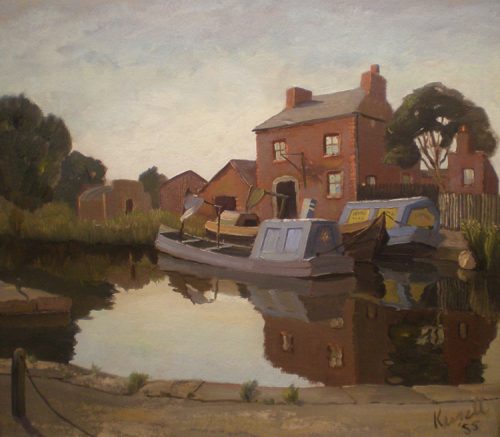 Oil on Board, 90x80cm. James Kessell 1915-1978 Provenance : Ex-private collection, R.O.I. exhibit 1953. Born in Coventry, James Kessell specialised in oils. He was the son of James Everett Kessell and studied at the Coventry School of Art from 1928-1934. He exhibited at numerous principal galleries including the Royal Academy, Royal Institute of Oil Painters, Royal Society of British Artists, Royal Society of Marine Artists etc. His work is held in a number of public collections.
Oil on Board, 90x80cm. James Kessell 1915-1978 Provenance : Ex-private collection, R.O.I. exhibit 1953. Born in Coventry, James Kessell specialised in oils. He was the son of James Everett Kessell and studied at the Coventry School of Art from 1928-1934. He exhibited at numerous principal galleries including the Royal Academy, Royal Institute of Oil Painters, Royal Society of British Artists, Royal Society of Marine Artists etc. His work is held in a number of public collections. -
Sold
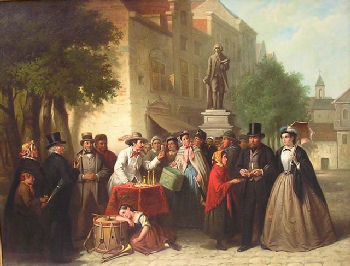 Oil on Canvas, 40x32cm. Jacobus Matthys Damschroeder 1825 - 1905 Born in Germany, Jan Damschroeder spent most of his life working in Amsterdam, where we believe this work to be set. He specialised in genre paintings, often with the inclusion of children. A painting entitled 'The Village School' was sold at a London auction house c.1900 for what was then the considerable sum of 30 guineas. Damschroeder worked in both oils and watercolours, often painting on a more modest scale than this example. It would seem that this is a major large work and was painted as an exhibition piece.
Oil on Canvas, 40x32cm. Jacobus Matthys Damschroeder 1825 - 1905 Born in Germany, Jan Damschroeder spent most of his life working in Amsterdam, where we believe this work to be set. He specialised in genre paintings, often with the inclusion of children. A painting entitled 'The Village School' was sold at a London auction house c.1900 for what was then the considerable sum of 30 guineas. Damschroeder worked in both oils and watercolours, often painting on a more modest scale than this example. It would seem that this is a major large work and was painted as an exhibition piece. -
Sold
 Oil, 40x30cm. Anthony Park R.O.I., R.B.A. 1880 - 1962 Park moved to St. Ives at the age of 18 and became probably the best known of the early St. Ives painters. He studied under Julian Olsson who encouraged him to study in Paris. From 1905 he attended the Atelier Colarossi where he was a contemporary of Modigliani. Strongly influenced by the French Impressionists, Park's work is always brightly coloured and spontaneous. He had worked in the cotton mills of his native Lancashire throughout much of his childhood. Although he had no official training during his first years painting in St. Ives, Park was fortunate enough to meet Julius Olsson, one of the earliest arrivals among the many painters who had settled in St. Ives towards the end of the nineteenth century. Olsson was the founder of the new School of Landscape and Marine Painting which he had set up in his own studio overlooking Porthmeor Beach. He offered Park free tuition on account of his willingness to learn and natural ability and within six years of arriving in St. Ives, Park had begun exhibiting at the Royal Academy and it was at this time, with Olsson's guidance, that he decided to continue his training in the ateliers of Paris. Returning to St. Ives in 1923, Park found the old fishing port provided him with countless subjects among the many boats coming and going in the busy harbour and the overlapping forms of the fisherman's cottages rising steeply on the hill overlooking the port. Park exhibited at the Royal Academy from 1905 to 1949 and he was elected as a member of the Royal Society of Oil Painters in 1923. He was a founder member of the St. Ives Society of Artists in 1927. With regular entries to the Paris Salon he was awarded the Gold Medal in 1934. Park was among a small group of professional artists who carried on the tradition of St. Ives painting in the quiet years between the wars. He exhibited costal and fishing scenes at the Royal Academy, the Paris Salon and St. Ives Society of Artists. His work is held in the public collections of Manchester City Art, Salford Art Gallery and the Tate.
Oil, 40x30cm. Anthony Park R.O.I., R.B.A. 1880 - 1962 Park moved to St. Ives at the age of 18 and became probably the best known of the early St. Ives painters. He studied under Julian Olsson who encouraged him to study in Paris. From 1905 he attended the Atelier Colarossi where he was a contemporary of Modigliani. Strongly influenced by the French Impressionists, Park's work is always brightly coloured and spontaneous. He had worked in the cotton mills of his native Lancashire throughout much of his childhood. Although he had no official training during his first years painting in St. Ives, Park was fortunate enough to meet Julius Olsson, one of the earliest arrivals among the many painters who had settled in St. Ives towards the end of the nineteenth century. Olsson was the founder of the new School of Landscape and Marine Painting which he had set up in his own studio overlooking Porthmeor Beach. He offered Park free tuition on account of his willingness to learn and natural ability and within six years of arriving in St. Ives, Park had begun exhibiting at the Royal Academy and it was at this time, with Olsson's guidance, that he decided to continue his training in the ateliers of Paris. Returning to St. Ives in 1923, Park found the old fishing port provided him with countless subjects among the many boats coming and going in the busy harbour and the overlapping forms of the fisherman's cottages rising steeply on the hill overlooking the port. Park exhibited at the Royal Academy from 1905 to 1949 and he was elected as a member of the Royal Society of Oil Painters in 1923. He was a founder member of the St. Ives Society of Artists in 1927. With regular entries to the Paris Salon he was awarded the Gold Medal in 1934. Park was among a small group of professional artists who carried on the tradition of St. Ives painting in the quiet years between the wars. He exhibited costal and fishing scenes at the Royal Academy, the Paris Salon and St. Ives Society of Artists. His work is held in the public collections of Manchester City Art, Salford Art Gallery and the Tate. -
Sold
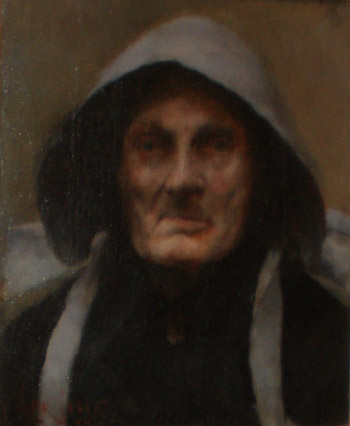 Oil on Canvas, 37x40cm. Costa 1867-1931 An important portrait from the Newlyn School by the highly desirable portrait painter John da Costa. The painting is signed and importantly dated 1890 when Newlyn painting and painters were at the height of their influence in British art. In 1890 a writer mentioned Stanhope Forbes' old studio and then went on 'Now it is occupied by the youngest member of the Newlyn colony, Mr. John da Costa, fresh from the Paris schooles, and barely twenty three, has yet had a picture on the line at the Grovesnor and another at the Academy'. John da Costa was born in Teignmouth and was recognised as an artist of great potential early in his career by Frederick, Lord Leighton. He received awards at the Paris Salon in 1906 and 1907, and he was a member of the Royal Institute of Oil Painters and the Royal Society of Portrait Painters. In 1974 a memorial exhibition was dedicated to John da Costa of paintings from the collection of Mrs. Elizabeth M. Richards at Leighton House, London.
Oil on Canvas, 37x40cm. Costa 1867-1931 An important portrait from the Newlyn School by the highly desirable portrait painter John da Costa. The painting is signed and importantly dated 1890 when Newlyn painting and painters were at the height of their influence in British art. In 1890 a writer mentioned Stanhope Forbes' old studio and then went on 'Now it is occupied by the youngest member of the Newlyn colony, Mr. John da Costa, fresh from the Paris schooles, and barely twenty three, has yet had a picture on the line at the Grovesnor and another at the Academy'. John da Costa was born in Teignmouth and was recognised as an artist of great potential early in his career by Frederick, Lord Leighton. He received awards at the Paris Salon in 1906 and 1907, and he was a member of the Royal Institute of Oil Painters and the Royal Society of Portrait Painters. In 1974 a memorial exhibition was dedicated to John da Costa of paintings from the collection of Mrs. Elizabeth M. Richards at Leighton House, London. -
Sold
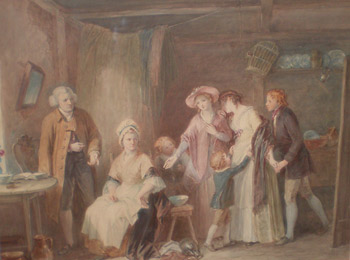 Watercolour, 72x63cm. Massey Wright 1777-1866 Provenance: Another version by the artist is in the collection of the Victoria and Albert Museum. Born in London, John Massey Wright began to exhibit at the Royal Academy in 1808. He married Ann Meadows in 1809 and they continued to live in central London. In 1820 he joined the Old Watercolour Society, and he continued to be a member until his death in 1866. Massey Wright produced several bodies of work as a figure painter, watercolourist and later as an illustrator, illustrating work by writers such as Walter Scott, Robert Burns, Mary Shelley and Byron.
Watercolour, 72x63cm. Massey Wright 1777-1866 Provenance: Another version by the artist is in the collection of the Victoria and Albert Museum. Born in London, John Massey Wright began to exhibit at the Royal Academy in 1808. He married Ann Meadows in 1809 and they continued to live in central London. In 1820 he joined the Old Watercolour Society, and he continued to be a member until his death in 1866. Massey Wright produced several bodies of work as a figure painter, watercolourist and later as an illustrator, illustrating work by writers such as Walter Scott, Robert Burns, Mary Shelley and Byron. -
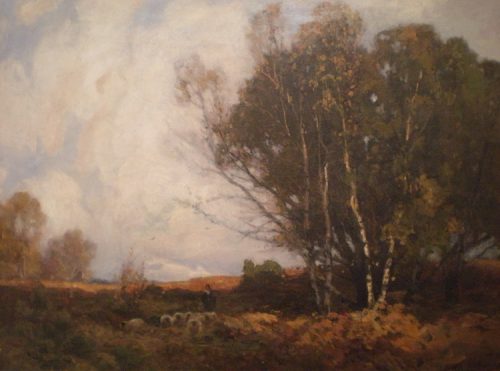 Oil on Canvas, 98x77cm. Noble Barlow R.B.A. 1861 - 1917 John Noble Barlow was born in Manchester in 1861. He studied art at the Academie Julian in Paris under Jules Joseph Lefebre, Paul Delance and Constant. After leaving Paris he continued his studies in Belgium, Holland and New York. He became a U.S. citizen in 1887 where he lived in Providence, Rhode Island, becoming a member of the Providence Art Club. During this period he exhibited at the National Academy of Design and the Art Institute of Chicago. Some five years later he returned to England and St. Ives. He soon gained a reputation and was elected a member of the Society of British Artists and was a successful medal winner at the Paris Salon in 1899 and in 1900 at the Paris Exposition. For many years he maintained a studio at Lamorna Valley. John Barlow was en exceptional landscape painter as this example clearly indicates. His work is held in a number of public collections both in the U.S.A. and at home. The Rhode Island School of Design museum currently displays three of his works. Many of the artist's pupils at the John Barlow School of Art became successful painters including Garstin Cox, William Cox, Herbert George, Anna Hills and Edgar Nye.
Oil on Canvas, 98x77cm. Noble Barlow R.B.A. 1861 - 1917 John Noble Barlow was born in Manchester in 1861. He studied art at the Academie Julian in Paris under Jules Joseph Lefebre, Paul Delance and Constant. After leaving Paris he continued his studies in Belgium, Holland and New York. He became a U.S. citizen in 1887 where he lived in Providence, Rhode Island, becoming a member of the Providence Art Club. During this period he exhibited at the National Academy of Design and the Art Institute of Chicago. Some five years later he returned to England and St. Ives. He soon gained a reputation and was elected a member of the Society of British Artists and was a successful medal winner at the Paris Salon in 1899 and in 1900 at the Paris Exposition. For many years he maintained a studio at Lamorna Valley. John Barlow was en exceptional landscape painter as this example clearly indicates. His work is held in a number of public collections both in the U.S.A. and at home. The Rhode Island School of Design museum currently displays three of his works. Many of the artist's pupils at the John Barlow School of Art became successful painters including Garstin Cox, William Cox, Herbert George, Anna Hills and Edgar Nye. -
Sold
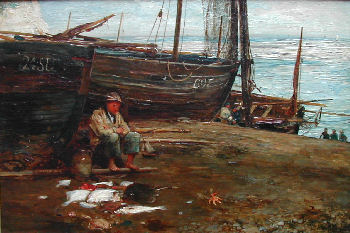 Oil on Canvas, 11x17cm. Robertson Reid 1857 - 1926 Born in Edinburgh, he studied at the Royal Scottish Academy Schools before moving to Cornwall and later to London. He became interested in the Social Realism movement and was probably influenced by Bastien Lepage. In 1879 his painting 'Toil and Pleasure' was hung at the Royal Academy, illustrating his debt to Lepage. That painting was purchased for the nation by the Chantrey Bequest. George Clausen was a friend of the artist and they lived close to each other in Hampstead. Clausen was stimulated by Reid's work and had a considerable influence at this time. Reid chose subjects of field workers and humble people and his style has a particular dynamism, influenced no doubt by the early teachings of Chalmers and McTaggart. A good colourist, he painted a number of works of fishermen and women with rich vibrant colours as this example illustrated. The artist knew the Glasgow Boys and influenced their early work. He was an important and influential Scottish artist.
Oil on Canvas, 11x17cm. Robertson Reid 1857 - 1926 Born in Edinburgh, he studied at the Royal Scottish Academy Schools before moving to Cornwall and later to London. He became interested in the Social Realism movement and was probably influenced by Bastien Lepage. In 1879 his painting 'Toil and Pleasure' was hung at the Royal Academy, illustrating his debt to Lepage. That painting was purchased for the nation by the Chantrey Bequest. George Clausen was a friend of the artist and they lived close to each other in Hampstead. Clausen was stimulated by Reid's work and had a considerable influence at this time. Reid chose subjects of field workers and humble people and his style has a particular dynamism, influenced no doubt by the early teachings of Chalmers and McTaggart. A good colourist, he painted a number of works of fishermen and women with rich vibrant colours as this example illustrated. The artist knew the Glasgow Boys and influenced their early work. He was an important and influential Scottish artist. -
Sold
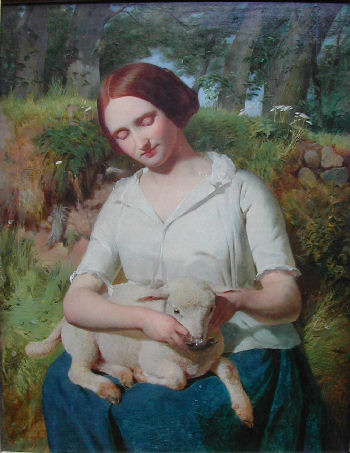 Oil on Canvas, 13x17cm. Stirling 1820 - 1871 Provenance: Exhibited at the Royal Academy 1853. John Stirling first exhibited three portraits at the Royal Academy in 1852. In the same year Holman Hunt's masterpiece 'The Hireling Shepherd' was hung in the Academy and it is more than likely that John Stirling would have seen the work of the Pre-Raphaelites for the first time on a visit to London from Aberdeen to see his own work hung. The work of the Pre-Raphaelites was first seen in 1849 and the brotherhood existed for a period of about five years from that date. It seems certain that John Stirling was impressed by the work of the Pre-Raphaelites and was influenced by them when he produced his painting 'The Lassie and the Lamb', which was exhibited at the Academy in 1853. The technique used by such artists as Holman Hunt and Millais was to paint in pure colour on a white, wet ground which produced a distinctive luminosity as was a technique Stirling also employed in 'The Lassie and the Lamb'. Similarly, the Pre-Raphaelite's great attention to detail and most particularly in the cases of Hunt and Millais, their wish to reflect nature accurately is reflected in John Stirling's painting. While the Pre-Raphaelite Brotherhood was not without its detractors, Charles Dickens for one, its great champion was the foremost Victorian critic and painter John Ruskin. He took notice of the work of John Stirling and in 'Academy Notes' of 1855 commented on Stirling's Academy painting: 'The Scottish Presbyterians' describing it as '...a very acceptable picture, showing careful study and good discrimination.' The title of the painting 'The Lassie and the Lamb' is taken from Wordsworth's poem 'The Pet Lamb', a pastoral. In later works, the artist took poetry for a direct inspiration for his subjects which were the Pre-Raphaelite Brotherhood's oeuvre. The Pre-Raphaelites had a considerable influence on a number of painters and there can be little doubt that John Stirling's painting 'The Lassie and the Lamb' falls safely into the Pre-Raphaelite category. John Stirling exhibited his first works at the Royal Academy in 1852 and continued to exhibit there until 1871, the year he died. His first paintings were exhibited from an Aberdeen address, although it seems he also lived in London, since the pictures were sent both from Aberdeen and London during his active years. A number of his later works are a result of his visits to Morocco in 1868 and 1869. His three exhibits at the Royal Academy in 1869 were 'Al Sok', a market in Morocco, 'Repas Honnetre' and Al-Ghirab, a water seller in Morocco.
Oil on Canvas, 13x17cm. Stirling 1820 - 1871 Provenance: Exhibited at the Royal Academy 1853. John Stirling first exhibited three portraits at the Royal Academy in 1852. In the same year Holman Hunt's masterpiece 'The Hireling Shepherd' was hung in the Academy and it is more than likely that John Stirling would have seen the work of the Pre-Raphaelites for the first time on a visit to London from Aberdeen to see his own work hung. The work of the Pre-Raphaelites was first seen in 1849 and the brotherhood existed for a period of about five years from that date. It seems certain that John Stirling was impressed by the work of the Pre-Raphaelites and was influenced by them when he produced his painting 'The Lassie and the Lamb', which was exhibited at the Academy in 1853. The technique used by such artists as Holman Hunt and Millais was to paint in pure colour on a white, wet ground which produced a distinctive luminosity as was a technique Stirling also employed in 'The Lassie and the Lamb'. Similarly, the Pre-Raphaelite's great attention to detail and most particularly in the cases of Hunt and Millais, their wish to reflect nature accurately is reflected in John Stirling's painting. While the Pre-Raphaelite Brotherhood was not without its detractors, Charles Dickens for one, its great champion was the foremost Victorian critic and painter John Ruskin. He took notice of the work of John Stirling and in 'Academy Notes' of 1855 commented on Stirling's Academy painting: 'The Scottish Presbyterians' describing it as '...a very acceptable picture, showing careful study and good discrimination.' The title of the painting 'The Lassie and the Lamb' is taken from Wordsworth's poem 'The Pet Lamb', a pastoral. In later works, the artist took poetry for a direct inspiration for his subjects which were the Pre-Raphaelite Brotherhood's oeuvre. The Pre-Raphaelites had a considerable influence on a number of painters and there can be little doubt that John Stirling's painting 'The Lassie and the Lamb' falls safely into the Pre-Raphaelite category. John Stirling exhibited his first works at the Royal Academy in 1852 and continued to exhibit there until 1871, the year he died. His first paintings were exhibited from an Aberdeen address, although it seems he also lived in London, since the pictures were sent both from Aberdeen and London during his active years. A number of his later works are a result of his visits to Morocco in 1868 and 1869. His three exhibits at the Royal Academy in 1869 were 'Al Sok', a market in Morocco, 'Repas Honnetre' and Al-Ghirab, a water seller in Morocco. -
Sold
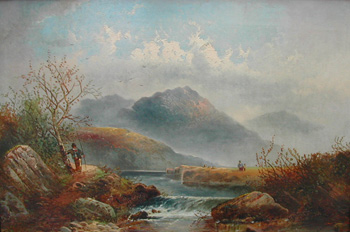 Oil on Canvas, 56x40cm. Joseph Horlor 1809 - 1887 One of the best known West Country painters of his period and like many others working at this time he visited Wales on frequent occasions. He adopted a free and loose style and his sense of light for dramatic effect is highly succesful. He exhibited at the Royal Academy, Suffolk Street and other principal galleries.
Oil on Canvas, 56x40cm. Joseph Horlor 1809 - 1887 One of the best known West Country painters of his period and like many others working at this time he visited Wales on frequent occasions. He adopted a free and loose style and his sense of light for dramatic effect is highly succesful. He exhibited at the Royal Academy, Suffolk Street and other principal galleries. -
Sold
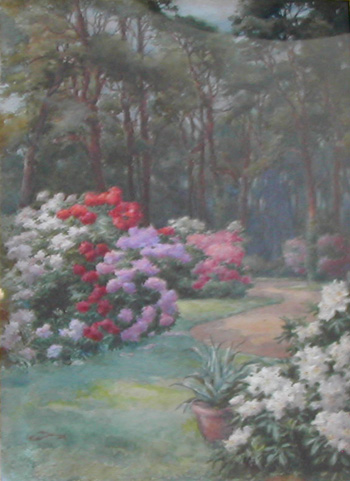 Watercolour, 44x54cm. Joseph Twigg 1884 - 1912 Provenance : Dudley Gallery (original label verso). A superb example of the work of watercolourist Joseph Twigg. In original condition it is mounted in an excellent water gilded watts frame. The artist specialised in landscape and architectural subjects and exhibited in London at principal galleries that included the Royal Academy and the Royal Institute. His principal gallery, the Dudley Gallery, was a regular venue for his work. He lived at various times in Walton on Thames, Eastbourne and Northwood in Middlesex.
Watercolour, 44x54cm. Joseph Twigg 1884 - 1912 Provenance : Dudley Gallery (original label verso). A superb example of the work of watercolourist Joseph Twigg. In original condition it is mounted in an excellent water gilded watts frame. The artist specialised in landscape and architectural subjects and exhibited in London at principal galleries that included the Royal Academy and the Royal Institute. His principal gallery, the Dudley Gallery, was a regular venue for his work. He lived at various times in Walton on Thames, Eastbourne and Northwood in Middlesex. -
Sold
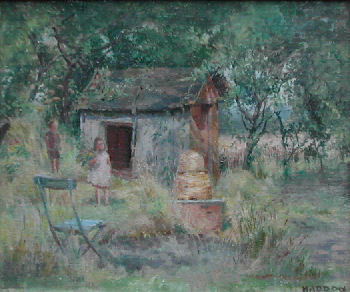 Oil on Board, 60x80cm. Joyce Critchley Haddon R.B.A., N.E.A.C. b.1915 Joyce Haddon studied at Cambridge and the Royal Academy schools where she won the Creswick medal for landscape and the Landseer prize for landscape, drawing and painting from the antique. Her work was exhibited at the Royal Academy with exhibitions in Paris, Sydney, Belfast, Birmingham and many more. She was elected a member of the Royal Society of British Artists and the New English Art Club, showing her work regularly at their annual exhibitions. Her daughter, the journalist Celia Haddon said of her mother, 'she saw the inward light in the commonplace'.
Oil on Board, 60x80cm. Joyce Critchley Haddon R.B.A., N.E.A.C. b.1915 Joyce Haddon studied at Cambridge and the Royal Academy schools where she won the Creswick medal for landscape and the Landseer prize for landscape, drawing and painting from the antique. Her work was exhibited at the Royal Academy with exhibitions in Paris, Sydney, Belfast, Birmingham and many more. She was elected a member of the Royal Society of British Artists and the New English Art Club, showing her work regularly at their annual exhibitions. Her daughter, the journalist Celia Haddon said of her mother, 'she saw the inward light in the commonplace'. -
Sold
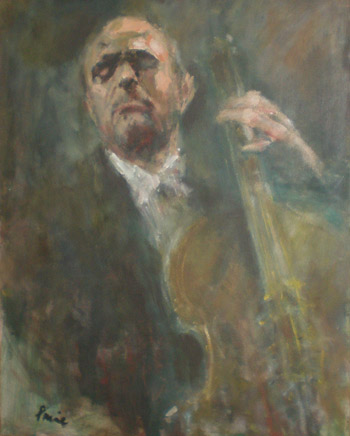 Oil on Canvas, 78x94cm. b.1926 Ken Paine was born in Lambeth, London in 1926. He studied at Twickenham College of Art and later with R.O. Dunlop RA. After travelling extensively for several years, the artist settled in the United States. It was during this time that he further developed his interest in portraiture, and of the character studies which have become his life's work. He travelled all around the States, painting people from all walks of life, before returning to England to set up his studio. Since 1962 the Royal Society of Portrait Painters and the Pastel Society have exhibited his work, and his commissions have included many dignitaries and celebrities. Paine is a member of the Pastel Society and the Societie des Pastellistes de France. He has won numerous awards for his portraiture both in the UK and France. His work has been exhibited widely over the years and he has held many solo exhibitions. In 1999 a major retrospective of his work was stages in Bath Museum. In 2004 Toulouse Museum acquired two of his works. Ken Paine works in all media, but pastel is the medium for which he is most well known. His work leans towards the romantic and shows genuine pathos without being sentimental. The vitality revealed in his portraits can be awe-inspiring. The artist's empathy with his subjects produces a quite unique artistic result which is admired world wide. A beautifully illustrated biography: 'Ken Paine - His life and work' by Michael Simonow, was published by Mechanick Excersises in 1997. In 2001 an hour long documentary on his life and work was commissioned by Sky Television's cultural channel. Purchased from a private collection, full provenance and additional information is available.
Oil on Canvas, 78x94cm. b.1926 Ken Paine was born in Lambeth, London in 1926. He studied at Twickenham College of Art and later with R.O. Dunlop RA. After travelling extensively for several years, the artist settled in the United States. It was during this time that he further developed his interest in portraiture, and of the character studies which have become his life's work. He travelled all around the States, painting people from all walks of life, before returning to England to set up his studio. Since 1962 the Royal Society of Portrait Painters and the Pastel Society have exhibited his work, and his commissions have included many dignitaries and celebrities. Paine is a member of the Pastel Society and the Societie des Pastellistes de France. He has won numerous awards for his portraiture both in the UK and France. His work has been exhibited widely over the years and he has held many solo exhibitions. In 1999 a major retrospective of his work was stages in Bath Museum. In 2004 Toulouse Museum acquired two of his works. Ken Paine works in all media, but pastel is the medium for which he is most well known. His work leans towards the romantic and shows genuine pathos without being sentimental. The vitality revealed in his portraits can be awe-inspiring. The artist's empathy with his subjects produces a quite unique artistic result which is admired world wide. A beautifully illustrated biography: 'Ken Paine - His life and work' by Michael Simonow, was published by Mechanick Excersises in 1997. In 2001 an hour long documentary on his life and work was commissioned by Sky Television's cultural channel. Purchased from a private collection, full provenance and additional information is available. -
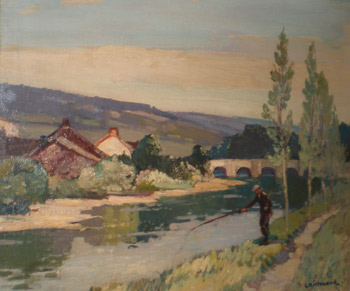 Oil on Canvas, 75x63cm. Leonard Richmond R.B.A., R.I., R.O.I., P.S. d.1965 Leonard Richmond studied at the Taunton School of Art and Chelsea Polytechnic. He was a prolific exhibitor at the Fine Art Society, Royal Academy, Cooling and Walker's Galleries and also showed widely overseas winning a number of awards. These included the Tuthill prize at the Chicago International Watercolour Exhibition in 1928 and in 1947 a silver medal at the Paris Salon.
Oil on Canvas, 75x63cm. Leonard Richmond R.B.A., R.I., R.O.I., P.S. d.1965 Leonard Richmond studied at the Taunton School of Art and Chelsea Polytechnic. He was a prolific exhibitor at the Fine Art Society, Royal Academy, Cooling and Walker's Galleries and also showed widely overseas winning a number of awards. These included the Tuthill prize at the Chicago International Watercolour Exhibition in 1928 and in 1947 a silver medal at the Paris Salon. -
Sold
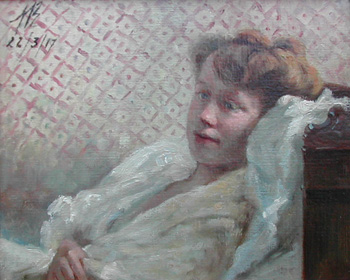 Oil on Board, 35x30cm. Marius Alexander Jacques Bauer 1867 - 1932 Considered one of the most important Belgian painters of his period this painting executed during the First World War is particularly poignant. The recent revival of interest in Orientalism has led to the rediscovery of the Dutch artist Marius Bauer. Bauer was an inveterate traveller, going off to India, Indonesia, Turkey, Palestine and Morocco among other destinations. In 1888 he was given the opportunity to make his first trip east, to Istanbul, by the art dealer E.J. van Wisselingh. He returned with more than 100 drawings and several full sketchbooks. This pattern repeated itself again and again. Among the cities he visited were Cairo, Luxor, Jerusalem, Agra and Benares. He was irresistably drawn to street life, the colourful populace and the exotic landscape of parts of the world that were then unfamiliar to most people. There Bauer found inspiration for spacious landscapes and picturesque city scenes. In addition to drawings, he also made etchings, aquarelles anf paintings. (Singer Museum)
Oil on Board, 35x30cm. Marius Alexander Jacques Bauer 1867 - 1932 Considered one of the most important Belgian painters of his period this painting executed during the First World War is particularly poignant. The recent revival of interest in Orientalism has led to the rediscovery of the Dutch artist Marius Bauer. Bauer was an inveterate traveller, going off to India, Indonesia, Turkey, Palestine and Morocco among other destinations. In 1888 he was given the opportunity to make his first trip east, to Istanbul, by the art dealer E.J. van Wisselingh. He returned with more than 100 drawings and several full sketchbooks. This pattern repeated itself again and again. Among the cities he visited were Cairo, Luxor, Jerusalem, Agra and Benares. He was irresistably drawn to street life, the colourful populace and the exotic landscape of parts of the world that were then unfamiliar to most people. There Bauer found inspiration for spacious landscapes and picturesque city scenes. In addition to drawings, he also made etchings, aquarelles anf paintings. (Singer Museum) -
Sold
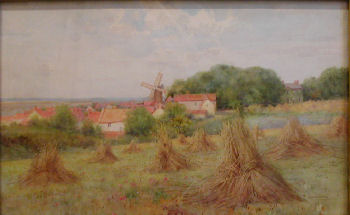 Hagarty exh. 1882 - 1928 A highly successful artist, Mary Hagarty was elected a full member of the Society of Women Artists in 1918. Principally a watercolour painter, she painted the landscape of England and Wales and held a strong affection for Venice where she exhibited many works of the city. She lived for some time in both London and Liverpool and exhibited 131 works at the Walker Art Gallery and numerous works at the principal London galleries, including the Royal Academy, Royal Institute and the Royal Society of British Artists.
Hagarty exh. 1882 - 1928 A highly successful artist, Mary Hagarty was elected a full member of the Society of Women Artists in 1918. Principally a watercolour painter, she painted the landscape of England and Wales and held a strong affection for Venice where she exhibited many works of the city. She lived for some time in both London and Liverpool and exhibited 131 works at the Walker Art Gallery and numerous works at the principal London galleries, including the Royal Academy, Royal Institute and the Royal Society of British Artists. -
Sold
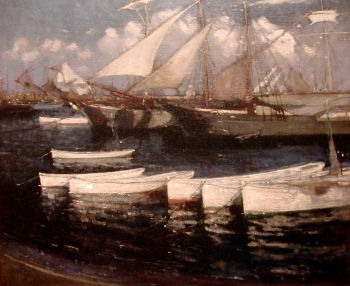 Oil on Canvas, 22x16cm. Maccrossan 1863 - 1934 Ex private collection. Provenance: Royal Academy Exhibit 1898 'White Gigs' no. 513 (This was Mary Maccrossans first Royal Academy Exhibit, purchased by the Liverpool Corporation in 1928). One of the most gifted of the early St. Ives painters, Mary Maccrossan won the acclaim of not only her critics but also her fellow artists. She was born in Liverpool and studied at the Liverpool School of Art then at Delacluse's in Paris and finally in St. Ives with Julius Olsson. This exceptional work with its silver grey palette illustrates her at her best. She exhibited at numerous leading London and Provincial galleries. Further details available on request.
Oil on Canvas, 22x16cm. Maccrossan 1863 - 1934 Ex private collection. Provenance: Royal Academy Exhibit 1898 'White Gigs' no. 513 (This was Mary Maccrossans first Royal Academy Exhibit, purchased by the Liverpool Corporation in 1928). One of the most gifted of the early St. Ives painters, Mary Maccrossan won the acclaim of not only her critics but also her fellow artists. She was born in Liverpool and studied at the Liverpool School of Art then at Delacluse's in Paris and finally in St. Ives with Julius Olsson. This exceptional work with its silver grey palette illustrates her at her best. She exhibited at numerous leading London and Provincial galleries. Further details available on request. -
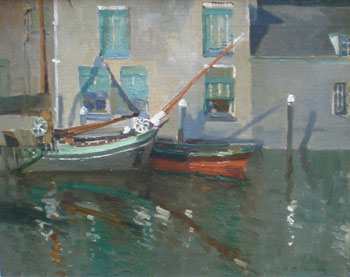 Oil on Canvas, 58x48cm. McCrossan 1863-1934 One of the most respected of the early St. Ives painters this exceptional example dates from circa 1910. Mary McCrossan was born in Liverpool and studied at the Liverpool School of Art before progressing on to the Academie Delecluse in Paris. On leaving Paris she then studied under Julius Olsson in St. Ives. She held several one-man shows at the Ballie and Beaux Arts galleries between 1909 and 1928. Lived in 126 Cheyne Walk and travelled extensively until 1929 when she moved to St. Ives permanently. Exhibited at the Royal Academy and the R.B.A.
Oil on Canvas, 58x48cm. McCrossan 1863-1934 One of the most respected of the early St. Ives painters this exceptional example dates from circa 1910. Mary McCrossan was born in Liverpool and studied at the Liverpool School of Art before progressing on to the Academie Delecluse in Paris. On leaving Paris she then studied under Julius Olsson in St. Ives. She held several one-man shows at the Ballie and Beaux Arts galleries between 1909 and 1928. Lived in 126 Cheyne Walk and travelled extensively until 1929 when she moved to St. Ives permanently. Exhibited at the Royal Academy and the R.B.A. -
Sold
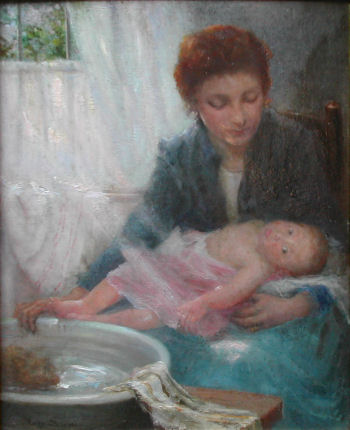 Oil on Canvas, 58x65cm. exh. 1889 - 1907 A wonderful and evocative painting by Mary Swan. A talented artist she was equally at home with various subject matter but excelled at these intimate scenes. She exhibited at numerous principal galleries both in London and in the provinces including the Royal Academy. She lived for much of her life in Bromley, Kent.
Oil on Canvas, 58x65cm. exh. 1889 - 1907 A wonderful and evocative painting by Mary Swan. A talented artist she was equally at home with various subject matter but excelled at these intimate scenes. She exhibited at numerous principal galleries both in London and in the provinces including the Royal Academy. She lived for much of her life in Bromley, Kent. -
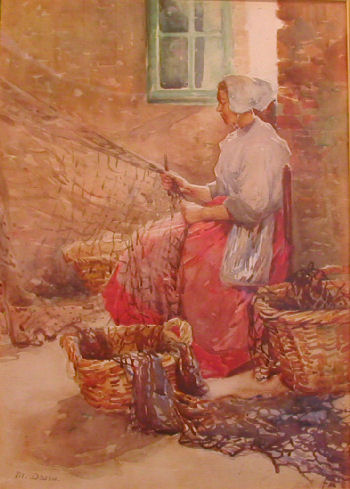 Miriam Deane exh. 1890's - 1927 A stunning watercolour by Miriam Deane who was born in Liverpool and later moved to London. An accomplished artist with a confident loose style she exhibited with considerable success at numerous venues both in London and the provinces including the London Salon, Waller Art Gallery, Liverpool and the Glasgow Institute.
Miriam Deane exh. 1890's - 1927 A stunning watercolour by Miriam Deane who was born in Liverpool and later moved to London. An accomplished artist with a confident loose style she exhibited with considerable success at numerous venues both in London and the provinces including the London Salon, Waller Art Gallery, Liverpool and the Glasgow Institute. -
Sold
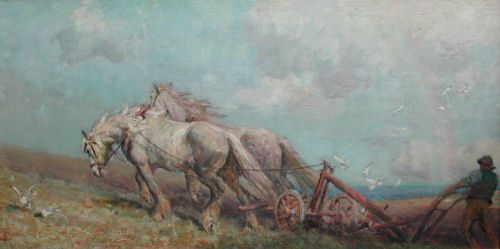 Oil on Canvas, 118x64cm. Nathaniel Hughes John Baird R.O.I. 1865 - 1935 Nathaniel Baird was born in Yetholm in Roxburghshire and was the son of John Baird the minister who is famed for his work in reforming the gypsy population and particularly for the founding of the first 'Ragged Schools'. Baird first studied under his father and then at the Coldstream Academy, Edinburgh, then London and later Paris. He had his first Royal Academy work accepted in 1883 and exhibited at many of the principal galleries from that date including the R.O.I. of which he was elected a member. He was equally at home with both oil and watercolour and a favourite subject was the heavy horse at work. He continued to exhibit until the 1930's. He moved to Devon in 1880 living at Dawlish where he was given an interesting commission by the Miller family of Torquay to paint portraits of the family. One of the sitters was the youngest daughter Agatha who was to gain worldwide fame as the crime writer Agatha Christie. Following the death of his wife in 1919 he moved from Devon to Sussex where he died in 1935.
Oil on Canvas, 118x64cm. Nathaniel Hughes John Baird R.O.I. 1865 - 1935 Nathaniel Baird was born in Yetholm in Roxburghshire and was the son of John Baird the minister who is famed for his work in reforming the gypsy population and particularly for the founding of the first 'Ragged Schools'. Baird first studied under his father and then at the Coldstream Academy, Edinburgh, then London and later Paris. He had his first Royal Academy work accepted in 1883 and exhibited at many of the principal galleries from that date including the R.O.I. of which he was elected a member. He was equally at home with both oil and watercolour and a favourite subject was the heavy horse at work. He continued to exhibit until the 1930's. He moved to Devon in 1880 living at Dawlish where he was given an interesting commission by the Miller family of Torquay to paint portraits of the family. One of the sitters was the youngest daughter Agatha who was to gain worldwide fame as the crime writer Agatha Christie. Following the death of his wife in 1919 he moved from Devon to Sussex where he died in 1935. -
Sold
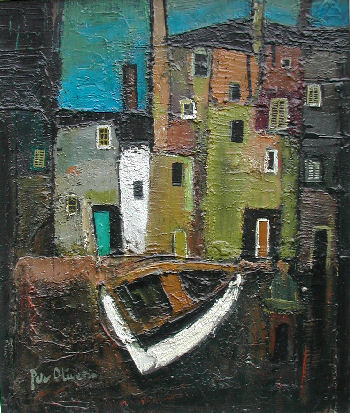 Oil on Board, 12x15cm. Oliver b.1927 Born in Jersey in the Channel Islands in 1927, he started painting during a prolonged illness and went on to study first at Exeter for his diploma in Painting and subsequently post-graduate studies in Liverpool. While still a student he exhibited work at the Redfern Gallery, London, and with the Royal Society of British Artists. Since those early days Peter Oliver has maintained strong links with the Redfern Gallery and has had a number of one-man shows with them. He has exhibited regularly in London and has also exhibited at the City Art Gallery in Salford. His work is in many collections, including the Tate Gallery, the Courtauld Institute, Manchester City Art Gallery and in the U.S.A. with the Fielding Collection New York, the Charles Berenson Collection etc.
Oil on Board, 12x15cm. Oliver b.1927 Born in Jersey in the Channel Islands in 1927, he started painting during a prolonged illness and went on to study first at Exeter for his diploma in Painting and subsequently post-graduate studies in Liverpool. While still a student he exhibited work at the Redfern Gallery, London, and with the Royal Society of British Artists. Since those early days Peter Oliver has maintained strong links with the Redfern Gallery and has had a number of one-man shows with them. He has exhibited regularly in London and has also exhibited at the City Art Gallery in Salford. His work is in many collections, including the Tate Gallery, the Courtauld Institute, Manchester City Art Gallery and in the U.S.A. with the Fielding Collection New York, the Charles Berenson Collection etc. -
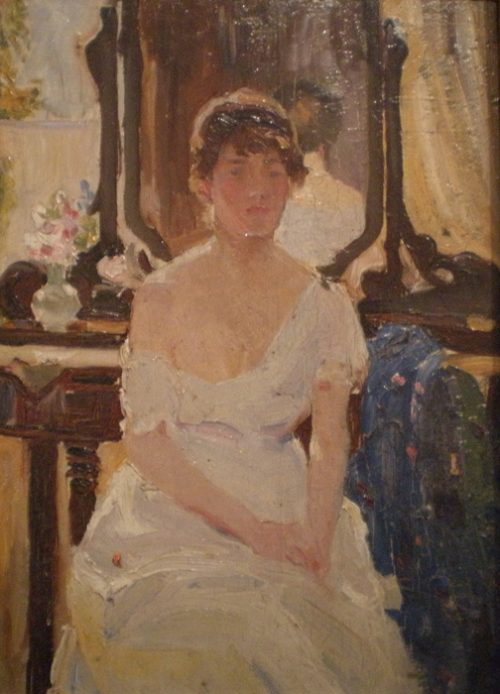 Oil on Board, 38x48cm. Connard R.A., R.W.S., N.E.A.C., N.P.S., I.S. 1875-1958 Born in Southport, Lancashire, he worked first as a house painter at the same time taking evening classes which resulted in him recieving a scholarship to the Royal College of Art to study textile design. His training as a painter began in 1898 when with the aid of a British Institution travelling scholarship he enrolled at the Atelier Julian in Paris. On his return he worked as an illustrator for Bodley Head. From 1909 he became a regular visitor with the New English Art Club and as a result developed a close relationship with Philip Wilson Street, often accompanying him on painting excursions. He quickly established himself as both a fine landscape and portrait painter and was a founder member of the National Portrait Society. He was invalided out of the army after the battle of the Somme and became an official war artist in the Royal Navy until 1918. Connard had a long and distingushed career, being elected a member of the Royal Academy in 1925.
Oil on Board, 38x48cm. Connard R.A., R.W.S., N.E.A.C., N.P.S., I.S. 1875-1958 Born in Southport, Lancashire, he worked first as a house painter at the same time taking evening classes which resulted in him recieving a scholarship to the Royal College of Art to study textile design. His training as a painter began in 1898 when with the aid of a British Institution travelling scholarship he enrolled at the Atelier Julian in Paris. On his return he worked as an illustrator for Bodley Head. From 1909 he became a regular visitor with the New English Art Club and as a result developed a close relationship with Philip Wilson Street, often accompanying him on painting excursions. He quickly established himself as both a fine landscape and portrait painter and was a founder member of the National Portrait Society. He was invalided out of the army after the battle of the Somme and became an official war artist in the Royal Navy until 1918. Connard had a long and distingushed career, being elected a member of the Royal Academy in 1925. -
Sold
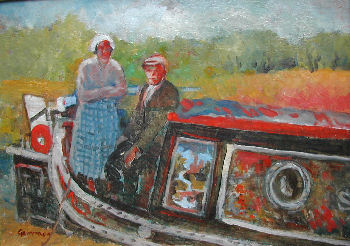 Oil on Board, 11x7cm. A painter, illustrator and writer Reg Gammon was born in Petersfield, Hampshire. In 1918 Muirhead Bone offered to get him into the Slade School but he declined as he had married. He took up instead a career as a writer and illustrator working for 'Punch' and for cycling and motoring magazines. Following the end of World War II, he moved back to the Black Mountains in Wales and became a hill farmer. It was in 1958 that Reg decided to become a full-time painter and moved to Somerset, setting up his studio in Cannington. His principal influence was Gaugin and this is evident in his lively pure palette. He achieved considerable success and was a member of both the R.W.A. and the R.O.I. In 1990 he published his biography 'One Man's Furrow, 90 years of country living'.
Oil on Board, 11x7cm. A painter, illustrator and writer Reg Gammon was born in Petersfield, Hampshire. In 1918 Muirhead Bone offered to get him into the Slade School but he declined as he had married. He took up instead a career as a writer and illustrator working for 'Punch' and for cycling and motoring magazines. Following the end of World War II, he moved back to the Black Mountains in Wales and became a hill farmer. It was in 1958 that Reg decided to become a full-time painter and moved to Somerset, setting up his studio in Cannington. His principal influence was Gaugin and this is evident in his lively pure palette. He achieved considerable success and was a member of both the R.W.A. and the R.O.I. In 1990 he published his biography 'One Man's Furrow, 90 years of country living'. -
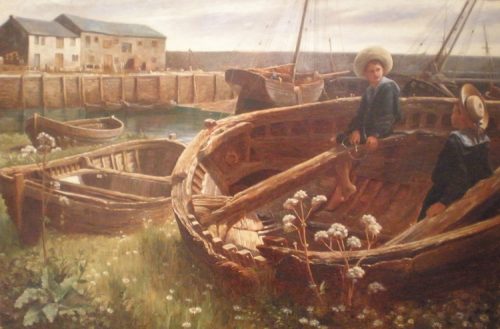 Oil on Canvas, 79x60cm. Robert Craig fl. 1879 - 1888 Little is known of this particularly gifted Scottish painter and his work is rarely on the market. He is known to have lived at Craegest, Dalkeith - an address from which exhibited five works at the Royal Scottish Academy. He also exhibited at the Glasgow Institute but appears not to have exhibited in England. Technically a fine painter with a good eye for composition, this is a delightful study from Victorian Scotland.
Oil on Canvas, 79x60cm. Robert Craig fl. 1879 - 1888 Little is known of this particularly gifted Scottish painter and his work is rarely on the market. He is known to have lived at Craegest, Dalkeith - an address from which exhibited five works at the Royal Scottish Academy. He also exhibited at the Glasgow Institute but appears not to have exhibited in England. Technically a fine painter with a good eye for composition, this is a delightful study from Victorian Scotland. -
Sold
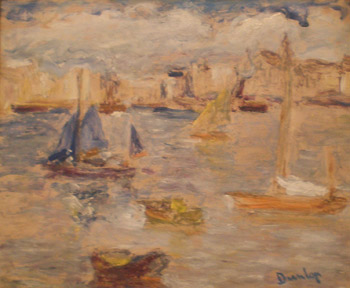 Oil on Board, 42x36cm. Ronald Ossory Dunlop R.A., R.B.A., N.E.A.C., L.G. 1896-1973 Provenance: Ex private collection. Born in Dublin, a painter of figure subjects, landscapes, portraits and still life. He was educated at Saffron Walden in Essex and worked for an advertising agency from the age of nineteen and after the First World War abandoned this for painting. He attended evening classes at the Wimbledon School of Art, and also studied in Manchester and Paris. In 1923 he founded the Emotionist Group of Writers and Artists. He held his first one-man show in 1928 at the Redfern Gallery. His work is represented in numerous public collections.
Oil on Board, 42x36cm. Ronald Ossory Dunlop R.A., R.B.A., N.E.A.C., L.G. 1896-1973 Provenance: Ex private collection. Born in Dublin, a painter of figure subjects, landscapes, portraits and still life. He was educated at Saffron Walden in Essex and worked for an advertising agency from the age of nineteen and after the First World War abandoned this for painting. He attended evening classes at the Wimbledon School of Art, and also studied in Manchester and Paris. In 1923 he founded the Emotionist Group of Writers and Artists. He held his first one-man show in 1928 at the Redfern Gallery. His work is represented in numerous public collections. -
Sold
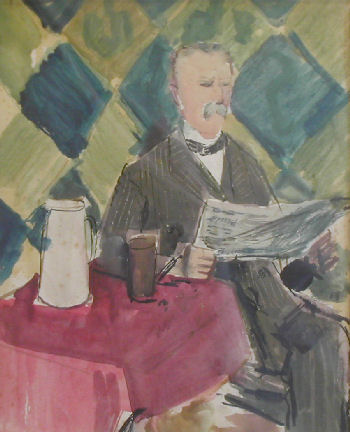 Watercolour, 70x90cm. Ruskin Spear R.A. 1911 - 1990 Born in Hammersmith, London, where he spent most of his life and which he frequently painted. An attack of polio as a child badly affected one leg so he attended Brook Green School for crippled children. At the age of fifteen he won a scholarship to the Hammersmith School of Art, another scholarship in 1930 taking him to the Royal College of Art for four year under William Rotherstein. Essentially an English painter in the Sickert tradition, his working class background was reflected in his pictures of seedy back streets and bar room life. An important painter, he painted many portraits, including Winston Churchill, Princess Anne, Margaret Thatcher, Lord Hailsham, Lord Olivier et al.
Watercolour, 70x90cm. Ruskin Spear R.A. 1911 - 1990 Born in Hammersmith, London, where he spent most of his life and which he frequently painted. An attack of polio as a child badly affected one leg so he attended Brook Green School for crippled children. At the age of fifteen he won a scholarship to the Hammersmith School of Art, another scholarship in 1930 taking him to the Royal College of Art for four year under William Rotherstein. Essentially an English painter in the Sickert tradition, his working class background was reflected in his pictures of seedy back streets and bar room life. An important painter, he painted many portraits, including Winston Churchill, Princess Anne, Margaret Thatcher, Lord Hailsham, Lord Olivier et al. -
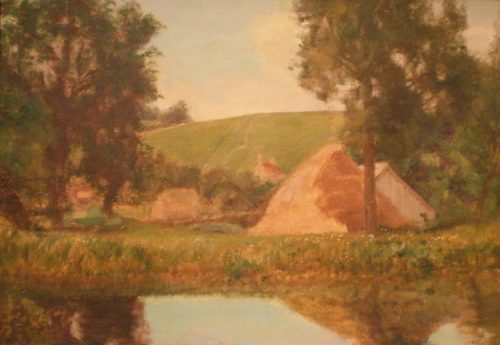 Oil on Canvas, 52x42cm. Murray R.A., P.R.I., R.S.A. 1849-1933 One of the most influential and respected painters of his period, David Murray was born in Glasgow. After spending eleven years with a mercantile firm he was to become an artist and studied at the Glasgow School of Art. In his early years he painted almost exclusively in Scotland before moving to London in 1883. Following this period he travelled extensively on the continent in particular Italy. He was knighted in 1918.
Oil on Canvas, 52x42cm. Murray R.A., P.R.I., R.S.A. 1849-1933 One of the most influential and respected painters of his period, David Murray was born in Glasgow. After spending eleven years with a mercantile firm he was to become an artist and studied at the Glasgow School of Art. In his early years he painted almost exclusively in Scotland before moving to London in 1883. Following this period he travelled extensively on the continent in particular Italy. He was knighted in 1918.

